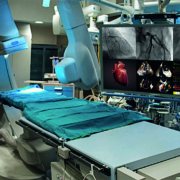Cath lab / EP lab & hybrid OR monitor failure rates skyrocket
A hospital or healthcare facility can be composed of dozens of departments. A catheterization lab, commonly referred to as cath lab or EP lab, is instrumentally vital to one of the busiest departments, cardiology. Hybrid OR’s are equipped with diagnostic imaging technology to give physicians visual access to chambers and arteries of the heart. In these areas, physicians perform life-saving procedures including coronary artery bypass graft surgery, balloon angioplasty, congenital heart defect closure, stenotic heart valves, and pacemaker implantations.
These acute procedures would not have been practicable without the appropriate technology to facilitate the imaging process. Cath lab operations are dependent on medical displays, as these monitors allow physicians to visualize a patient internally and perform the necessary procedure. In a single medical procedure, up to 4-6 monitors can be utilized at any time for enhanced visibility.
Although many monumental advancements have been made in the efficiency of cath labs, the dependence on X-rays for imaging has persisted through every upgrade. From purchasing analogue or digital modalities to choosing a single or bi-plane system, there are endless customization possibilities. Typically, the rooms are equipped with an image intensifier, C-arm, X-Ray tubes, and several displays.
Advantageously, the digital age ushered in an era of improvements to imaging technology, which emitted less radiation, and displayed visual clarity. The adoption of CRT monitors in the cath lab inherently changed how labs ran.
In the early cath labs, all information was conveyed through film. The X-rays, produced high-doses of radiation and low-quality images, which were printed on 16-mm or 35-mm film. Then, radiologists spent many hours of the day in darkrooms to process images, and ample storage space was wasted holding boxes of film.
With the implementation of picture archiving and communication systems (PACS), the transition from analogue to digital technology was concretized. PACS is an all-in-one program that provides electronic storage, retrieval, distribution, and presentation of radiology images.
In the cath lab, there are typically four to six CRT or LCDs in use. One image is always utilized for monitoring physiological attributes like a patient’s heart rate or blood oxygen level. Following CRT displays was the adaptation of LCD monitors. Many physicians upgraded to these monitors since they are slimmer, more portable, and offer higher resolution images.
“We are witnessing yet another transition in Cath Lab, Hybrid OR monitors as many physicians are upgrading from CCFL HD displays to ultra-high-definition 4K/8MP technology” says Michael Thomas Director of Business Development & Marketing at Ampronix. Many healthcare facilities have upgraded or are currently in the process of upgrading their medical displays to this resolution. These monitors provide a level of visibility previously unknown to physicians. During critical surgeries and procedures, increased clarity and sharper details can mean the difference between saving or losing a life.
These 4K/8MP large medical-grade displays are considered to be the new “gold standard” for surgical applications, allowing multiple screens to be viewed on a single monitor while taking up a minimal amount of space. When a 4K/8MP display is combined with a video manager, it can become customizable with a variety of layout options and editing tools like magnification. The design is easier to use and provides a higher resolution, making its adoption an easy choice as it facilitates precise procedures and minimally invasive surgeries.
Although the advancement of this technology has improved patient care, the transition made could prove to be detrimental and may demand considerable attention. With four to six displays in the cath lab previously, there are preventative measures in place that guarantee a backup option should a monitor burn out. In critical imaging procedures like angioplasty, mere seconds without visibility become crucial moments, and a single display makes cath labs extremely susceptible to all the risks associated.
To solve this issue, some displays are equipped with a secondary back-up monitor that folds out, if needed. However, this is a sacrifice that presents limited visual acuity. When this situation unravels, the entire procedure must be halted and the patient sutured up, as technicians attempt to remedy the problem.
Furthermore, any display failure amounts to an entire cath lab rendered obsolete until a replacement or repair solution is provided. Unfortunately, the turn around time for either of those protocols can take over a week.
THE SOLUTION
Ampronix has been repairing & selling 4K monitor’s sized 56”, 58”, & 60” for Cath Labs, & Hybrid OR’s to hospitals for years.
We are able to sell, service and repair the follwing Cath Lab monitor manufactures:
Philips, GE, Siemens, Shimadzu, Toshiba, Hitachi, Eizo, Barco, Chilin, Optik View
• Savings on costs and reduced downtime
• Most models are in stock and sold at half the OEM price
• Next day delivery by 10am or same day delivery available
• Services include preventive maintenance, replacement of LCD, backlights, reflectors, and power supplies
• Remote adjustments are available
We know how important your Cath Lab is and want to ensure you have Zero Downtime in the event your monitor will need service or replacement.
We offer:
• Nationwide requests received by 2pm PST will receive same or next day delivery
• A readily available response team to assist and answer questions for urgent repairs
• ESD and ASQ certified technicians
• Capable and competent customer service representatives for all your medical
technology questions and concerns


